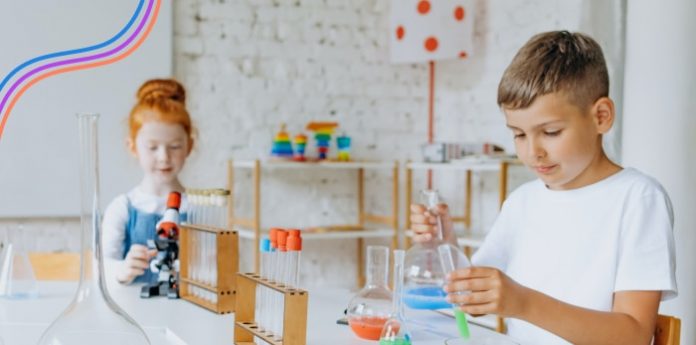STEM (science, technology, engineering, and math) activities can inspire children to develop a natural curiosity about the world. From making paper circuit boards to building a balloon car, children can do dozens of STEM activities daily to boost creativity and cognitive processing.
Math & ELA | PreK To Grade 5
Kids see fun.
You see real learning outcomes.
Watch your kids fall in love with math & reading through our scientifically designed curriculum.
Parents, try for free Teachers, use for free
Parents can also extend topics kids may have learned online or through school to practical applications. Kids can pick up an intuitive sense of practical applicability, with visual learners understanding subjects better through observation of experiments. STEM activities also encourage confidence and autodidactic learning through curiosity-driven testing.
STEM activities are also fun and can be performed by kids of all ages. Let’s do one STEM activity every day for the next 25 days!
25 STEM Activities for Young Explorers & Curious Thinkers

1. Lemon Volcano – Acid and base reaction
You can place food coloring and prep the volcano’s base by cutting a hole inside a few large lemons. Adding baking soda will make the volcano erupt, making it one of the more visual STEM activities kids can be amazed by.
2. Marble Run – Gravity
By sticking half-tube cardboard cylinders to a wall and making a racing course for marbles, kids can learn about the effects of gravity and kinetic energy. Marbles can be made to fall through a range of twists and turns to learn why the ball pauses to change course.
3. Popsicle Catapult – Potential energy
You can start by stacking 5-6 popsicle sticks and tying each end with rubber bands. For the catapult, you can tie two sticks on one end and slide the open ends to cover the top and bottom of the stack. You can attach a bottle cap to hold the projectile and fire away.
4. Candy Gears – Transfer of energy and work
Parents can take large plastic jar lids and stick skewers through them as placeholders. They can add candy to the ends of the skewers to create makeshift gear. Parents can make the other one turn through energy transfer by rotating one candy gear. It’s one of the simplest STEM activities to teach kids about engineering.
5. Water Walking – Surface tension, Capillary effect
Place 6 cups, 3 with colored water, and three empty ones in a row. Place paper towels between each cup, thereby connecting them like a train. The cup water should start flowing into the empty ones by the capillary effect.
6. Paper Roller Coaster – Momentum
This DIY arts & crafts STEM activity allows kids to use their imagination and create and calculate a slope, a loop, and a soft-landing mechanism for their cardboard roller coaster. Kids learn about momentum and acceleration by dropping marbles from the top through this intuitive experiment.
7. The Magical Wind car – Energy flow and Newton’s Law of motion
You can make a toy car out of bottle caps as wheels, skewers as the wheel balancers, and a cardboard sheet as the car’s base. Attaching a sail at the center, made of a skewer and a thin sheet of paper, will prepare the magical car. A gust of wind is all you need to make this mechanism run-free.
8. The Tea Bag Rocket – Hot air rising
This simple experiment can be done to demonstrate how hot air particles can quickly rise upwards while appearing to defy gravity. By emptying a tea bag and lighting it on fire, it will rapidly fly up in the air to the amazement of onlookers.
9. Flipping Arrows – Light refraction
Parents can make two arrows pointing in the same direction on a sheet of paper. A glass bottle with water can serve as the refraction medium. By sliding the paper behind the glass, there will be one section where an arrow will start to point in another direction.
10. Homemade Sundial – Rotation of the Earth
Kids can split a paper plate into 12 equidistant spaces with tape markers and add a pencil as a shadow caster in the center. By placing the sundial outside and synchronizing it at noon, kids can measure the time on the clock just by looking at the pencil’s shadow.
Related Reading: Fantastic Summer Camp Kids Activities
11. Changing Colors – Capillary action in plants
Taking a few celery stalks, some glasses of water, and different types of food coloring, kids can learn how small vegetable vessels carry nutrients into leaves. Celery stalks can be inserted into the colored water and left for a few hours to have them magically turn into different colors.
12. Seeds Growing into Plants – Germination
Taking a few sprout beans and individually placing them in cotton balls can help showcase the effects of germination. You can add these cotton balls to mud and water them regularly to have them sprout through the cotton across different stages.
13. Paper Circuit – Resistance and electric flow
You only need a graphite pencil, an AA battery, and LED lights for this STEM experiment. You can connect alligator clips to the battery and draw a straight line from one end of a sheet of paper to another. The line should act as a resistor, and by sliding the LED, you can make it light up or dim down.
14. Toy Sailboats – Buoyancy
Parents can attach a stick to a cork bottle and add a sheet of paper as a sail for this DIY sailboat. The sailboat should float on water due to the buoyant nature of cork, which can be compared to other items such as heavy toys, plastic bottles, fruit, etc.
15. Atmosphere in a Bag – Condensation
Add some water to a tightly closed zip-lock bag and have it rest outside in the sun. The water should evaporate and stick to the bag’s inner surface as water droplets, demonstrating the effects of condensation. They should turn back into water after being placed indoors.
16. Impossible Bags – Strength of polymers
Have your kids poke a hole straight through a zip-lock bag full of water. No water should leak out of the holes. This is because of the strength of polymer chains that want to combine and stick rather than let out any space after puncturing.
17. Marshmallow Heartbeat – Cardiac functioning
Biology-focused STEM activities can be performed excitingly and engagingly. Sticking a toothpick into a small marshmallow helps kids measure their heart rate and understand reading a pulse. The marshmallow can be placed on the wrist, with kids measuring the minuscule jumps in the marshmallow per minute.
18. Automatic blowing Balloons – Reactivity of chemicals
You can fill a plastic bottle with vinegar and a balloon with baking soda. Placing the balloon over the bottle will make the two chemicals react, creating air that automatically fills the balloon.
19. Magical Carousel – Movement of air particles
Have a carousel stuck into the center of a paper plate, with unlit candles under the carousel at equal distances. Light the candles and watch the carousel spin without any physical touch. The invisible movement of air can be demonstrated quite magically through this experiment.
Related Reading: Exciting Back to School Activities for Kids of Different Grades
20. Music with bands – Doppler effect, sound acoustics
Placing six rubber bands over a container will help create a musical instrument. Kids can pluck rubber bands and play different notes on the scale based on their position and thickness. Pulling the instrument away from the ear will also distort the frequency.
21. Egg Walk – Pressure dispersion
By having your kids walk on a crate of eggs, you can demonstrate the power of pressure dispersion. Since their foot pressure is equally distributed across multiple eggs, there is less chance of cracking.
22. Suction of Cups – Atmospheric pressure
Have moist tissue paper in the middle of a tray and place a candle on top of it. Light the candle and set a glass over it until it goes out. The air inside of the glass should create a pressure difference from the air outside, allowing you to lift the entire tray by just picking up the glass.
23. Dissection & Inspection – Biology, anatomy of flora
You can select multiple types of flowers and dissect them to compare their differences from a reference point. The stems of lotuses can be compared with roses, and the petals of sunflowers can be compared with lilies.
24. Invisible Power – Static electricity
Have a plate of scrap paper bits on the table and rub a balloon on your hair to generate static electricity. The scraps of paper should move around because of the charge of the balloon, demonstrating the invisible power of static electricity.
25. How to Float an Egg – Difference in density
While an egg sinks in freshwater, it can float effortlessly by adding salt to the glass. This is a great STEM activity to show how salt increases water density, allowing the less dense egg to float on the surface.
Children love STEM activities and enjoy exploring science and technology to fuel their curiosity.
SpashLearn understands children’s innate desire to learn new things in a fun and engaging environment constantly. Kids can learn about their favorite subjects through innovative math and ELA quizzes, courses, and worksheets with animated games and positive reinforcement.
Parents can sign up for free for our COPPA-certified courses!
Have a question? Ask us here – help@splashlearn.com
Frequently Asked Questions
Why are STEM activities important?
STEM activities are vital to developing an intuitive sense of exploration within science and technology.
What is a STEM activity for kids?
A STEM activity can be any activity designed around exploring a STEM topic or a group of distinct topics and their role in the result.
How do you explain STEM to a student?
STEM subjects can be taught to students of all ages through practical examination, experimentation, and engaging in dialogue about STEM topics.
What are STEAM activities?
STEAM stands for STEM + Art, which involves DIY crafts and other artistic explorations that encourage creative thinking in younger children.
























